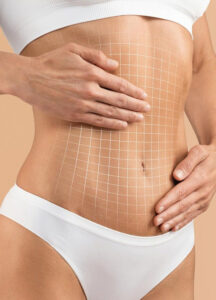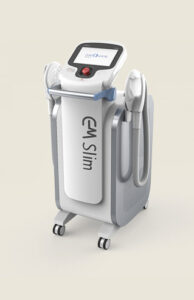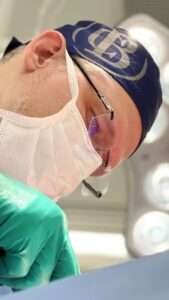

Lipo on the abdomen and other areas
Liposuction and Liposculpture
Liposuction or liposculpture surgery consists of removing fat from the body, in the space between the skin and the muscles, in order to reduce accumulations in places considered unsightly, with or without reintroducing it, with the aim of improving body contour.
It is carried out through small incisions in the skin, which allow the introduction of a cannula which, connected to the liposuction machine, will suck out the desired or possible amount of fat.
The maximum amount to be liposuctioned is proportional to body weight, 5% of the weight if no adrenaline solution is infiltrated (dry technique) or 7% of the weight if adrenaline solution is infiltrated (wet technique or “HYDROLIPO”).
The body contour is altered, but this change is limited by the thickness of the fatty tissue. Large amounts of fatty tissue all over the body hinder the result, while bony prominences or muscle contours cannot be altered with this surgical technique. For example: wide hips will remain so, without being affected by bone structure, just as the belly can remain protruding if there is an association between muscle flaccidity and fat accumulation.
Further information about liposuction
- LIPOASPIRATION – LIPOESCULPTURE does not in itself cause any known pathology.
- The aim of this surgery is to improve body contour.
- IT’S NOT WEIGHT LOSS SURGERY.
- It will be necessary to wear a girdle compressing the operated area for up to two months, with daily wear varying according to the post-operative period.
- Scars evolve according to the nature of each person and are usually barely noticeable, especially in the penumbra. If changes occur, there are treatments that can be used in an attempt to improve the appearance of the scars.
- You may experience hardened areas under the skin. These are scars (fibrosis) in the fat where the liposuction machine has passed through. Like other scars, the time it takes for them to become imperceptible varies from person to person. There are physiotherapy procedures that can speed up this process. Small depressions or elevations can also occur, which correspond to irregularities that have remained in the fatty tissue.
- For correction, new liposuction may be necessary.
- Purple spots (ecchymoses), partial or total, temporary or permanent loss of sensation in certain areas undergoing treatment may occur.
- Minor bleeding and secretions may occur from the surgical wounds, especially in the sacral region. These can last up to 10 days and should be reported to your surgeon.
- Everything possible and technically feasible will be done to achieve a satisfactory result with just one surgical procedure, but secondary procedures may be necessary to improve the result.
- You will be a person with a better body contour (less localized fat), but maintaining this contour will depend on your behavior in the post-operative period, including maintaining or even losing weight.
- WEIGHT GAIN COULD ALTER THE RESULTS OBTAINED FROM THE SURGERY.
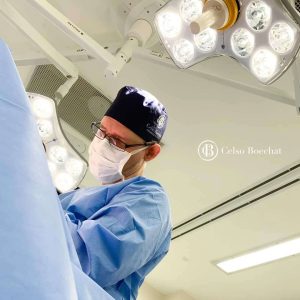

Using your fat
Fat Grafting
All the fat removed during lipo can be grafted into places that need volume, such as the buttocks, as well as imperfections, breast reconstructions and other types of repair, giving a natural and 100% rejection-free volume, according to the doctor’s and patient’s wishes, in these and other places on the body.
Preoperative Liposuction / Liposculpture (lipos)
- 1. Obey the instructions given for admission
- 2. Report any abnormalities that may occur in their general condition.
- 3. Enter hospital fasting for at least 8 hours and do not bring valuables into the hospital.
- 4. Come accompanied to the hospital.
- 5. Avoid wearing earrings, rings, piercings, colored nail polish, etc. Any of these will be removed before surgery.
- 6. The recommended belt should be taken to the hospital.
Post-operative Liposuction / Liposculpture (lipos)
- 1. avoid exertion for 30 days.
- 2. Stand up as many times as recommended on discharge from hospital, observing the periods of sitting down and avoiding maximum exertion. Mobilize lower limbs.
- 3. Do not expose yourself to the sun or cold for at least 14 days.
- 4. Obey the doctor's prescription.
- 5. Return to the office for subsequent dressings, on the days and at the times stipulated.
- 6. Don't worry about the intermediate forms in the various phases. Ask your surgeon any questions you may have.
- 7. Normal diet (except in special cases). We recommend a high-protein diet (meat, eggs, milk) as well as fruit.
- 8. Wait to go on your "diet or slimming regime" once you've been cleared by your doctor. Anticipating such conduct on your own could lead to difficult consequences.
Other body procedures
Before and After - Liposuction and Liposculpture


Surgeries and procedures performed by Dr. Celso Boechat
Other Plastic Surgeries in Rio de Janeiro
From stunning beaches to vibrant aesthetics, discover the plastic surgeries that reflect Rio de Janeiro’s beautiful spirit and dynamic aesthetic standards.
Breast surgery
Raise your self-esteem, reaffirm your beauty.
Body Surgeries
Transformations for your ideal body.
Facial surgery
Facial renewal, bring out your true expression.
Liposuction and Liposculpture
Liposuction and liposculpture: The most asked questions about liposuction
Liposuction is a procedure designed to remove localized fat deposits. It can be performed on areas of the body where fat naturally accumulates, such as the flanks, back, legs, “culottes”, thighs, arms, face and abdomen – the latter being one of the most frequently chosen areas. It is crucial to note that liposuction can be performed on multiple regions simultaneously, as long as the amount of fat removed does not exceed the recommended limits to ensure patient safety.
Since it is a surgery that removes a certain amount of fat, there will obviously be a reduction in weight, which varies according to each patient’s body volume. However, it is not the “kilos” removed that will define the aesthetic result, but rather the proportions that each specific area maintains with the others. The detailed evaluation of three items: skin elasticity, amount of fat and its location, allows us to optimize the result. In cases where the patient is very overweight, we recommend prior weight loss treatment in order to balance their body weight. There are cases where it is necessary to remove fat from certain areas and reintegrate it into others in order to increase volume. Some or all of this fat may be reabsorbed. It is not possible to predict what percentage of this fat will remain.
The scars resulting from liposuction are minimal, located on different parts of the body to allow access to the areas to be operated on. They vary in size from 0.5 to 1 cm and are designed to be as inconspicuous as possible. The scars will be permanent and will change over time. Each patient behaves differently from another in terms of the evolution of the scars, and in some cases they may even become imperceptible.
Certain patients may be prone to unsightly scarring (hypertrophic and keloid scars). This fact should be discussed during the initial consultation, as well as your family characteristics. Fair-skinned people tend to develop this type of scarring less often.
Various clinical and surgical resources allow us to improve these unsightly scars at the right time. However, hypertrophic or keloid scars should not be confused with the natural evolution of the mediate healing period. Any doubts about your healing progress should be clarified during your post-operative visits, when you can assess the stage you are at.
Various clinical and surgical resources allow us to improve these unsightly scars at the right time. However, the “mediate period” of normal healing (from the 30th day to the 12th month) should not be confused with a healing complication. Any doubts about your progress should be clarified with your doctor.
In the previous answer, some comments were made about the evolution of the scar. However, there are still a few observations to be made about the new abdomen, in terms of its consistency, sensitivity, volume, etc.
- In the first few months, the abdomen is relatively numb, as well as being subject to periods of “bloating”, which should subside spontaneously. At this stage, the abdomen may look “stretched” or “flat”.
- Over the months, once you’ve started exercising, you’ll gradually achieve the definitive result. Any result before 12 to 18 months after surgery should not be considered definitive.
Generally, yes. Depending on your torso type (chest + abdomen), we can achieve a natural result. Also of great importance in this respect is the thickness of the panniculus adiposus (fat thickness) covering the body, the elasticity of the skin and the greater or lesser flaccidity of the rectus abdominis muscles.
Your gynecologist will be able to advise you on the advisability of a new pregnancy. As for the outcome, you can’t predict it, it’s advisable to have the offspring already defined before the tummy tuck.
Not usually. Liposuction or liposculpture is usually painless. Any discomfort can be solved with the use of common painkillers.
Every medical act includes a variable risk and plastic surgery as part of medicine is no exception. You can minimize the risk by preparing each patient properly, but you can’t eliminate it completely. The surgical risk is not very different from other plastic surgeries, when there are no aggravating factors and the usual surgical medical care is in place.
Assisted general, peri-dural or local anesthesia, depending on the areas to be treated.
Depending on the extent of the areas to be treated, the time is variable. However, surgical time should not be confused with the length of time the patient stays in the operating room, as this also includes the period of anesthetic preparation and post-operative recovery.
The length of stay also varies according to the extent of the area treated and the anesthesia used. Usually 12 to 24 hours.
Yes. Semi-compressive dressings with special straps, maintained for a variable period, up to months.
From the 4th. To the 12th. day depending on the location.
After 24 to 72 hours depending on the extent of the surgery. Or at the doctor’s discretion.
Until the desired result is achieved, several evolutionary phases are characteristic of this type of surgery. This is why edema (swelling), “spots” of blood infiltrate, hypersensitivity of some areas, insensitivity of others, are common to all patients; obviously, some patients will present these phenomena with greater or lesser intensity than others. Your body will take care of these little inconveniences. Any concerns you may have should be passed on to your surgeon, who will provide you with the necessary clarification to put your mind at ease. A short period of “emotional depression” may occur in the first few days, due to the transitory aspect, usually stemming from the “anxiety to achieve the final result as soon as possible”. Be patient. Remember that no results can be evaluated less than 3 to 6 months after the operation. Complementary procedures in gyms, with beauticians or even physiotherapists, can greatly improve the final result; muscle shaping is a major factor in the new body contour.
Possible risks of liposuction
PLASTIC SURGERY, like any other surgery, has risks and complications, some of which are specific to it and others that are generic to any type of surgery. These include:
Generic
1. Allergies: Some medications or products used during surgery can cause allergic reactions, which can even lead to death. Allergic reactions are patient-dependent and can occur either to medicines or products that the patient has never had contact with, or to those that they have had previous contact with, even if they didn’t have a previous reaction.
2. Infection: Our body is colonized by countless bacteria, with which, at first, we live in extreme harmony. However, after surgery, they can cause infection, requiring treatment with antibiotics and rarely re-operation.
3. Hematoma: Accumulation of blood in the operated area, from a vessel that was not bleeding at the end of the operation, but did so in the immediate post-operative period. It can be treated by aspiration with a syringe and needle or, rarely, re-operation may be necessary.


Book your appointment
Find out everything you need in one consultation
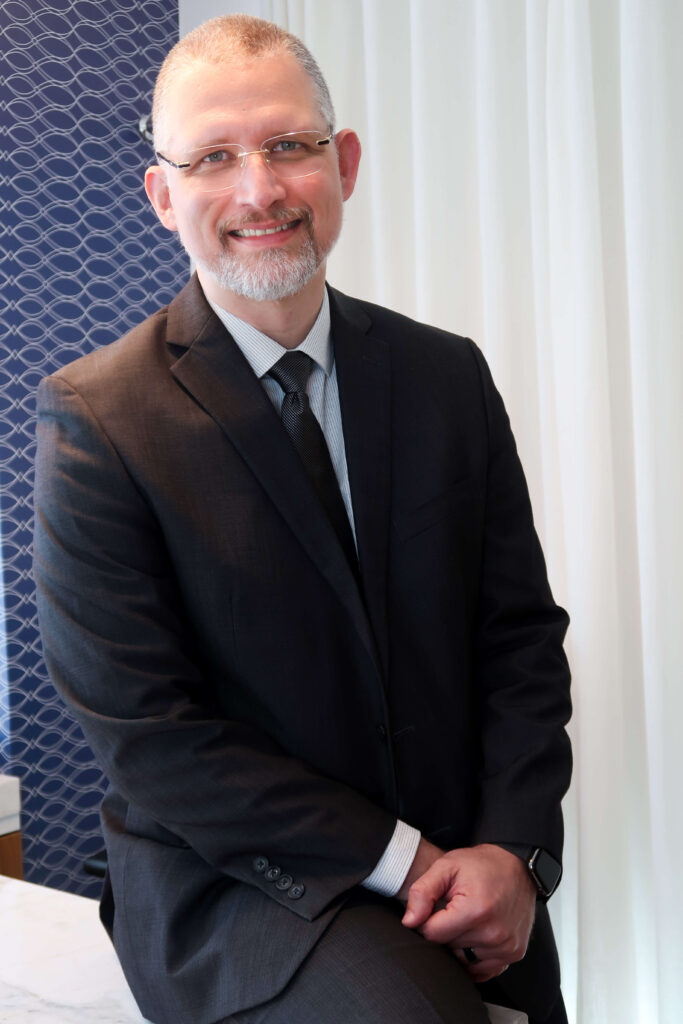

Appointment
Make an appointment and get your questions answered
Schedule an appointment with plastic surgeon Dr. Celso Boechat. Discover the path to aesthetic transformation and improved self-esteem. Our specialized team is ready to guide you through the procedure options, answering your questions and creating a personalized plan to suit your needs. Book your appointment now and take the first step towards a more confident and radiant version of yourself.
Send a message via WhatsApp
Service and consultations
Call Us
(21) 997336862
Opening hours
Monday to Friday - 09:00 - 21:00
Saturdays and Sundays - Closed, only for surgeries
